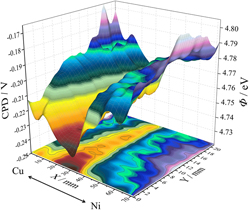Crossref Citations
This article has been cited by the following publications. This list is generated based on data provided by
Crossref.
Grill, Carina Daniela
Kollender, Jan Philipp
and
Hassel, Achim Walter
2015.
Electrodeposition of cobalt–nickel material libraries.
physica status solidi (a),
Vol. 212,
Issue. 6,
p.
1216.
Hafner, Martina
Burgstaller, Wolfgang
Mardare, Andrei Ionut
and
Hassel, Achim Walter
2015.
Aluminium–copper–nickel thin film compositional spread: Nickel influence on fundamental alloy properties and chemical stability of copper.
Thin Solid Films,
Vol. 580,
Issue. ,
p.
36.
Grill, Carina Daniela
Pötzelberger, Isabella
Kollender, Jan Philipp
and
Hassel, Achim Walter
2016.
Cobalt–nickel material libraries obtained from electrodeposition using citrate or glycine as additives.
physica status solidi (a),
Vol. 213,
Issue. 6,
p.
1417.
Pötzelberger, Isabella
Mardare, Andrei Ionut
and
Hassel, Achim Walter
2017.
Non-enzymatic glucose sensing on copper-nickel thin film alloy.
Applied Surface Science,
Vol. 417,
Issue. ,
p.
48.
Ravindra, K.
and
Hari Prasad Reddy S. Uthanna, M.
2017.
Electrical and optical properties of DC reactive magnetron sputtered CuNiO 2 films: Effect of annealing temperature.
Materials Today: Proceedings,
Vol. 4,
Issue. 14,
p.
12505.
Grill, Carina Daniela
Kollender, Jan Philipp
and
Hassel, Achim Walter
2017.
Preparation and investigation of combinatorially electrodeposited zinc-nickel, zinc-cobalt, and zinc-nickel-cobalt material libraries.
physica status solidi (a),
Vol. 214,
Issue. 9,
p.
1600706.
Jaatinen, Salla K.
Karinen, Reetta S.
and
Lehtonen, Juha S.
2017.
Liquid Phase Furfural Hydrotreatment to 2‐Methylfuran with Carbon Supported Copper, Nickel, and Iron Catalysts.
ChemistrySelect,
Vol. 2,
Issue. 1,
p.
51.
Rozsypal, Jan
Riman, Daniel
Halouzka, Vladimir
Opletal, Tomas
Jirovsky, David
Prodromidis, Mamas
and
Hrbac, Jan
2018.
Use of interelectrode material transfer of nickel and copper‑nickel alloy to carbon fibers to assemble miniature glucose sensors.
Journal of Electroanalytical Chemistry,
Vol. 816,
Issue. ,
p.
45.
Dehdari Vais, R.
Yadegari, H.
Sattarahmady, N.
and
Heli, H.
2018.
An anodized nanostructure of Ni/Cu alloy synthesized in ethaline for electrocatalytic oxidation and amperometric determination of l-carnitine.
Journal of Electroanalytical Chemistry,
Vol. 815,
Issue. ,
p.
134.
Pötzelberger, Isabella
Mardare, Cezarina Cela
Uiberlacker, Lisa Maria
Hild, Sabine
and
Hassel, Achim Walter
2018.
Optimum Copper-Palladium Catalyst from a Combinatorial Library for Sensitive Non-Enzymatic Glucose Sensors.
Electrocatalysis,
Vol. 9,
Issue. 3,
p.
359.
Becker, M.
Gies, M.
Polity, A.
Chatterjee, S.
and
Klar, P. J.
2019.
Materials processing using radio-frequency ion-sources: Ion-beam sputter-deposition and surface treatment.
Review of Scientific Instruments,
Vol. 90,
Issue. 2,
Koziarskyi, D. P.
Koziarskyi, I. P.
and
Maistruk, E. V.
2024.
Nanooptics and Nanoelectronics, Nanobiotechnology, and Their Applications.
Vol. 312,
Issue. ,
p.
165.



